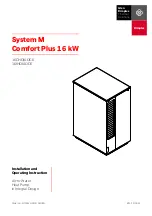
Hydraulic installations
Hydraulic accessories
20
Neptune solenoid pump
NSP-M
Operating instructions
This problem can occur:
n
With the high amplitudes of the vibrations.
n
When using long pipes (the severity of the pulsation increases with
the length of the pipe).
n
When using rigid piping instead of elastic hoses.
Notes on assembly:
n
You should carry out assembly in the direct vicinity of the location
where you want to damp the pressure peaks (directly in front of the
suction valve or directly behind the pressure valve).
n
Pulsation dampeners should be installed with throttle valves or
back-pressure valves installed directly behind them. By setting the
valves appropriately, you can further-optimise damping of the
pulsations.
n
To prevent unnecessary pipe friction losses, you should lay the
connecting line straight and in accordance with the rated width of the
pulsation dampener.
n
You must separately fasten relatively large pulsation dampeners and
ones with hose connections.
n
Pipelines must not transfer any mechanical tensions onto the
pulsation dampener.
8.7.5 Priming aid
Priming aids are particularly advisable:
n
In the case of dosing pumps with small volumetric displacements per
stroke or with low stroke length settings.
n
With high suction hights.
n
With highly dense dosing media.
n
At priming for the first time due to dry valves and air in the suction line
and the dosing head.
n
In dosing systems with frequent downtimes.
Further advantages resulting from priming aids:
n
Preventing cavitation in the suction line.
n
Gas removal.
n
Optical dosing control with small amounts.
n
Smoothing of the suction flow.
8.7.6 Level monitoring
Level monitoring of suction-side feeding of the dosing medium to prevent
the tank being sucked dry and to ensure that it can be topped up again in
good time.
8.7.7 Dosing of suspensions
When dosing suspensions, the dosing head must be rinsed regularly to
prevent depositing. To do this, you install a feed line for the rinsing
medium (water) in the suction side installation.
8.7.8 Suction pressure regulator
A suction pressure regulator may be necessary if the suction-side
installation of the system demonstrates a varying suction pressure or
supply pressure:
n
Dosing pumps that are installed above dosing tanks deliver less as the
tank empties, since the suction head increases.
n
Dosing pumps that are installed below dosing tanks deliver less as the
tank empties, since the positive delivery pressure reduces.
Further problems that can occur:
n
Greater wear on the dosing pump, e.g. diaphragm rupture due to the
effects of heavy forces with particularly high tanks and high-density
dosing media.
n
Idling of the dosing tank in the case of a diaphragm rupture or pipe
breakage.
n
Impermissibly high forces in the pump transmission that occur when
dosing pumps receive the dosing medium directly from the pressure
line.
n
Reduced performance or destruction of fittings due to cavitation with
long suction lines.
Installing a suction pressure regulator is a remedy for the problems
above. The suction pressure regulator is opened by the dosing pump's
suction pressure. This ensures that no dosing medium can flow if the
dosing pump is not running or no vacuum can be generated following a
pipe fracture.
Notes on assembly:
n
When using a large suction pressure regulator, you should provide a
pulsation dampener on the suction side.
Содержание NSP-M
Страница 2: ......
Страница 33: ... 33 Subject to technical changes Neptune solenoid pump NSP M Operating instructions ...
Страница 34: ... 34 Neptune solenoid pump NSP M Operating instructions ...
Страница 35: ... 35 Subject to technical changes Neptune solenoid pump NSP M Operating instructions ...
Страница 36: ......
















































